Gray
Whale facts and figures
This page is intended to give school students reliable and easy to use information about Baja gray whales. Good luck with your reports. It is also great for a quick refresher before you head out for a day of coastal whale watching.
Gray Whale (eschrichtius
robustus)
Basic facts:
Length about 40 to 50 feet. Weight about 50,000 to 80,000 pounds. Lifespan probably 50 to 80 years. Just like people, once they reach middle age, they seem to get broader . The Gray Whales have a double blow hole. Gray whales are known as baleen whales because they don't have teeth, but a filter-like material replaces teeth.
Length about 40 to 50 feet. Weight about 50,000 to 80,000 pounds. Lifespan probably 50 to 80 years. Just like people, once they reach middle age, they seem to get broader . The Gray Whales have a double blow hole. Gray whales are known as baleen whales because they don't have teeth, but a filter-like material replaces teeth.
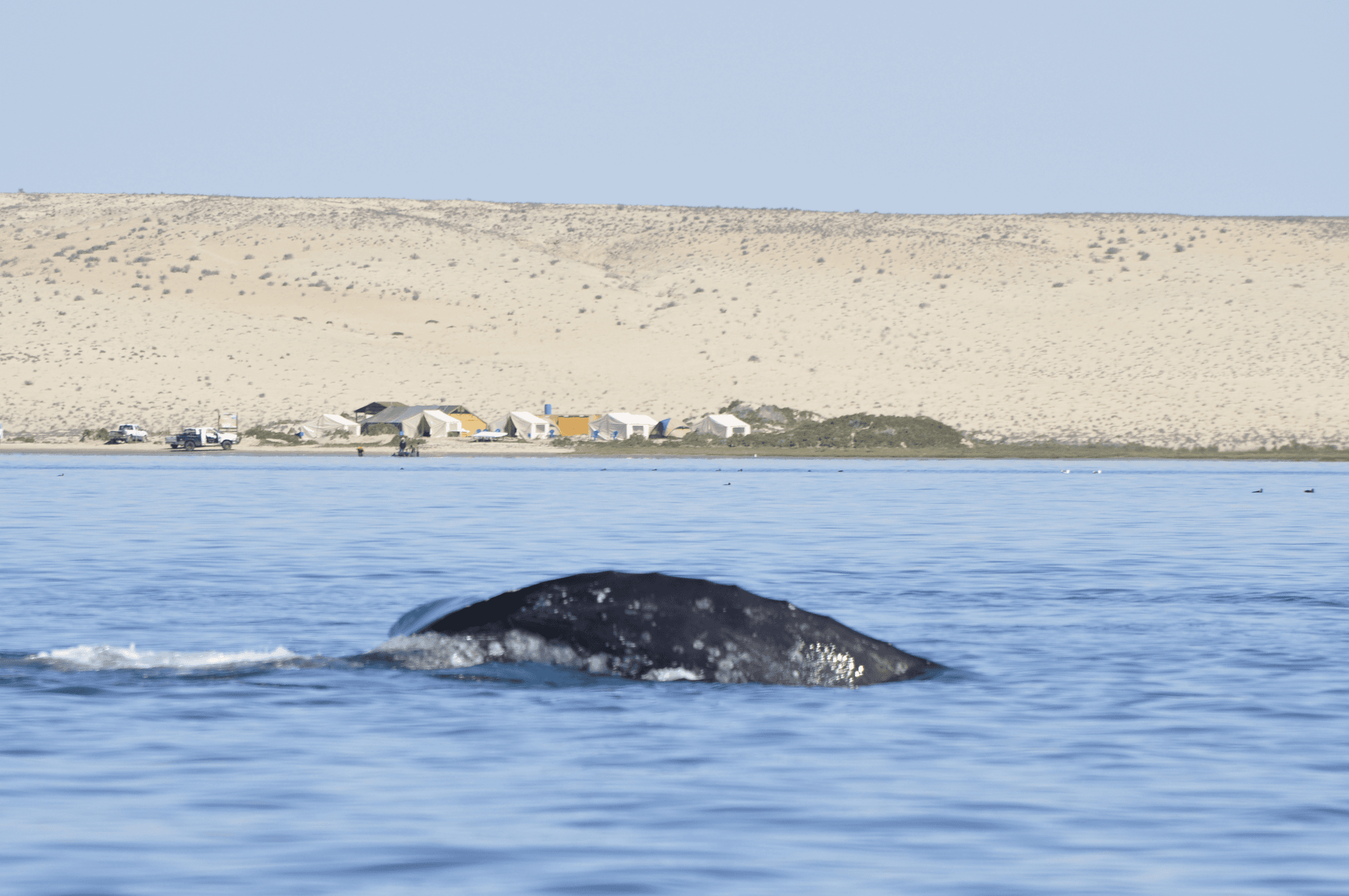
Our shoreside upscale tented lodge (camp) is now open for gray whale season in Baja.
The most comfortable tent accommodations on any Baja shore.
If you love whales like we do, then you probably already know about the friendly gray whales. No whale watching experience anywhere compares to this.
Okay, that's the ad, enjoy the information on this page about the gray whales. Check out my book, it's really made for whale watchers and is a great asset to have with you on any whale watching trip.
All the elder grays carry scars and tooth rake marks from encounters with Orcas. The X at the tip of this tail is an example. You will also see light gray or white scars where the whale barnacles have fallen off. Youngsters develop barnacle patches soon after birth. There is a noticable correlation between how many barnacles the mother has and how many develop on the baby. JJ the gray whale, was rescued by Sea World San Diego in the 1997 southward migration and released after a year in captivity, during the 1998 northward migration. When I visited Sea World JJ had virtually no scars nor barnacles.
CLICK here
to email our expert
Click here
to buy
my Gray Whale book
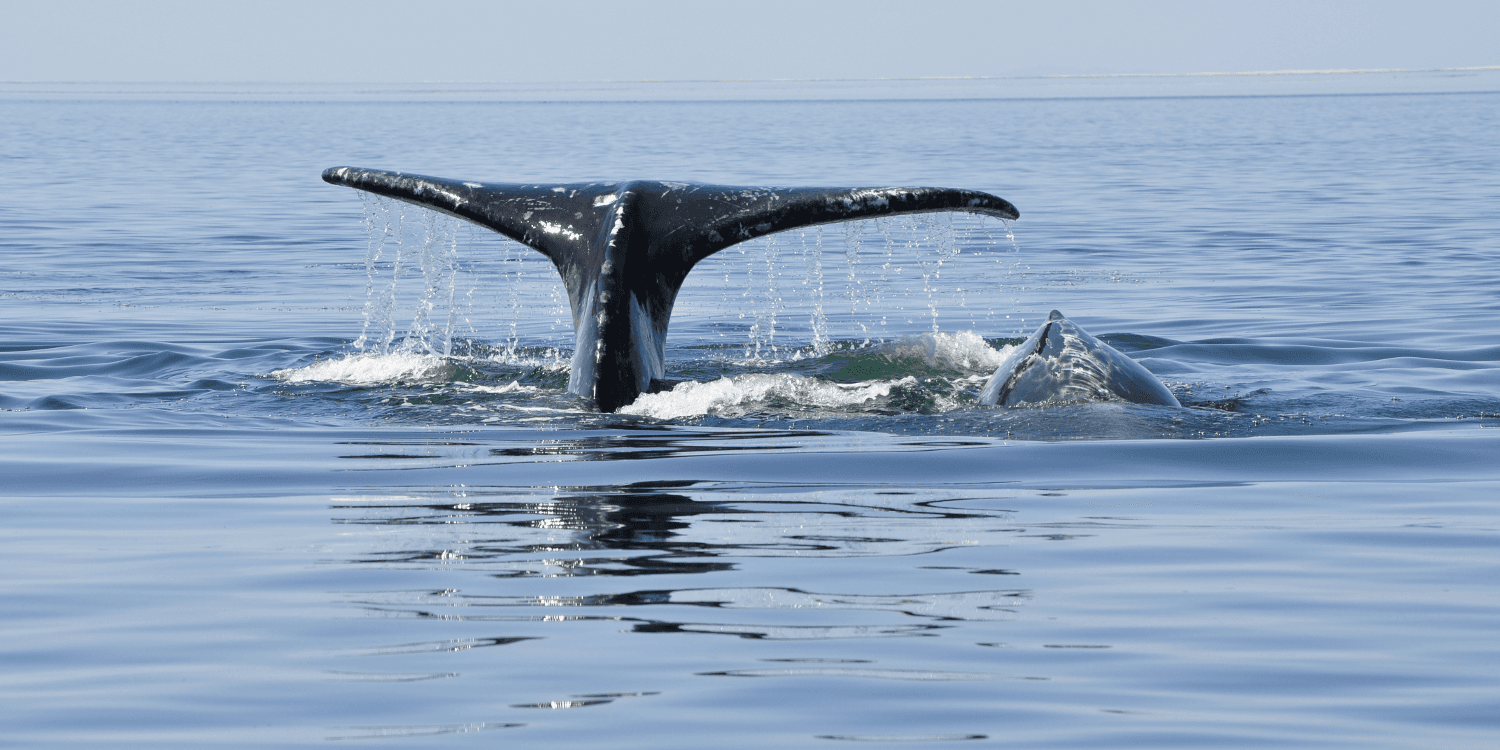
The dimples on
the young calf are where you can see the baby's facial hair when you get close
enough. This dimply shortened face is characteristic of all very young Gray
Whales. Notice his eye is just above water level. This is not spyhopping.
Many times the youngsters will lunge from the water like this to get a better look
at us watchers! !
Click here for information from
our only sponsor:
Baja Jones Adventure Travel
Great adventure, really close encounters with tons of
whales!
Kingdom - - - - -
Animalia- - - - - - - the animal kingdom
phylum - - - - - - - Chordata- - - - - - with a backbone
class- - - - - - - - - - Mammalia- - - - - all mammals have hair,
are livebearing, and
are warm blooded
order- - - - - - - - - - Cetacea- - - - - - -Whales and dolphins
sub order- - - - - - -Mysticeti- - - - - - - -Baleen whales as
opposed to the odontoceti
(toothed whales)
family- - - - - - - - - - Eschrichlidae
genus - - - - - - - - - Eschrichtius
species- - - - - - - - -robustus
phylum - - - - - - - Chordata- - - - - - with a backbone
class- - - - - - - - - - Mammalia- - - - - all mammals have hair,
are livebearing, and
are warm blooded
order- - - - - - - - - - Cetacea- - - - - - -Whales and dolphins
sub order- - - - - - -Mysticeti- - - - - - - -Baleen whales as
opposed to the odontoceti
(toothed whales)
family- - - - - - - - - - Eschrichlidae
genus - - - - - - - - - Eschrichtius
species- - - - - - - - -robustus
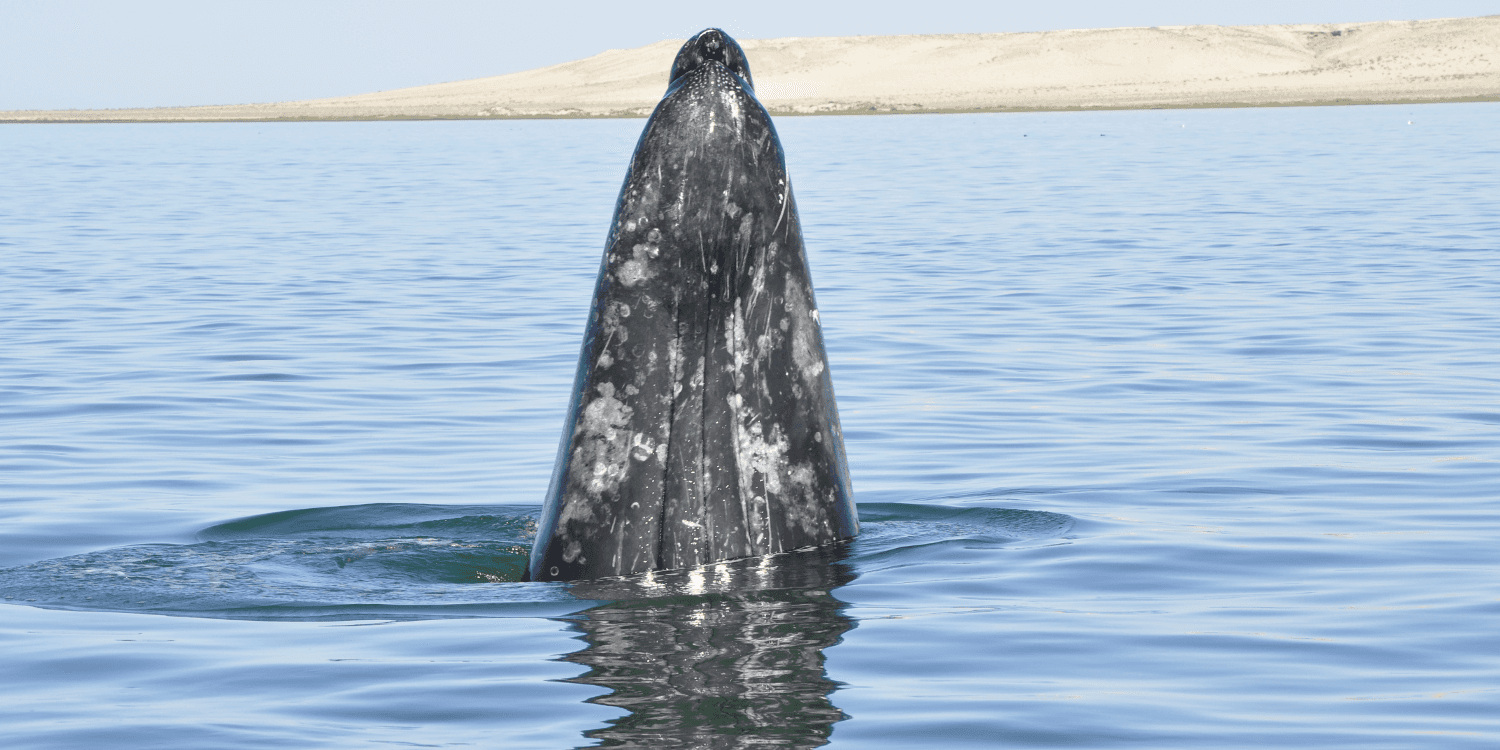
Whales are mammals. They breath air, have hair (calves have hairs around the front of their heads), are warm blooded, and give birth to live offspring that suckle milk from their mothers. The gray whale is in the sub-order Mysticeti. The Mysticeti whales have baleen instead of teeth. The male gray whale can reach 45 feet, while the female can reach 50 feet and weigh 30 or 35 tons. The largest grey whales have flukes, or tails, that may span ten feet.
The gray whale has two blowholes, and between 9 and 14 dorsal
nodules on its back, instead of a back fin. A gray whale spout or blow can reach up to 15
feet, and resembles a heart shape from the front or behind. The natural color of the gray
whale is dark gray. Often the skin is discolored from barnacle scars left on the skin.
While they are in the Northern waters, the gray whales feed mostly on tiny, shrimp-like
amphipods. Amphipods are very abundant in the northern waters during the summer
because the longer days produce more phytoplankton and zooplankton, the food
amphipods feed upon.
Gray whales are the only bottom feeding whale. The amphipods they live on thrive in
the muddy bottoms of the North Pacific Ocean. A single gray whale is believed to
turn over 50 acres of sediment during a season of feeding. The mud thus churned is
oxygenated, exposed to the nutrient rich water and is in effect seeded for the next years
harvest. An unseen, insiduous hazard to the species is the clogging of the bottoms
of many bays and shorelines by muddy runoff from upstream clear cut timber lands. The
eroded mud is carried into the mouth of the rivers and settles out of the water,
covers the bottom and chokes the life from the sediment.
During feeding, the gray whale appears to
prefer using its right side to scour the bottom and find its food. This has been
noted by several long time observers. To feed they gulp mouthfuls of mud from the
bottom, then use the whiskery baleen as a filter to drain out the unwanted material.
This leaves the amphipods stuck to the baleen inside their mouths. They then use their
tongues to loosen the amphipods from the baleen, and swallow.
During migration and while in calving
areas, gray whales eat very little, although they occasionally will eat shrimp-like mysids
or small fish at the surface. Thus the blubber they add during the summer feedings must
provide energy for the remainder of the year. Many whales may go without food for 3, 4 or
even 5 months! Recent research at Laguna Ojo de Liebre has shown that there are
critters in the muddy bottom upon which the whales may feed. If you look at my
Whaletails
page, you will see several photos that I point out as
characteristic of feeding whales. These photos were taken at Laguna Ojo de
Liebre. I believe that at least some of the gray whales spend much time bottom
feeding in the Mexican lagoons.
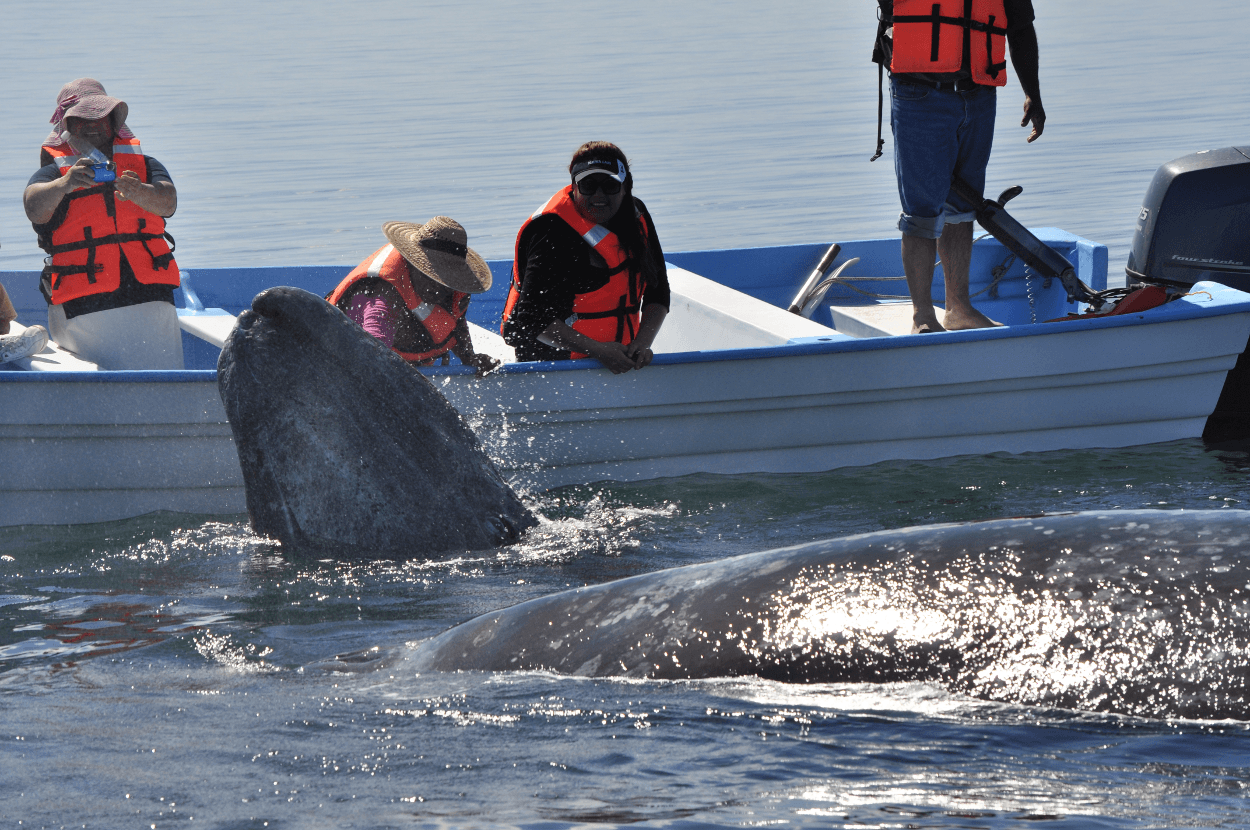
Here is my theory about why the Gray Whale
species population rebounded so quickly. I've been asked this question several times
recently. Here is the difficult to find answer.
All other species of whales, such as the Blue Whale, give birth to their
baby in the open ocean. The baby whale does not know how to swim when it is born. The
mother must help it to the surface and support it while it takes the first breath of air.
The open ocean water is rough and turbulent. There are many large predators lurking nearby
when a mother whale gives birth. They are drawn by the blood that gets into the water as
the baby whale is born.
The majority of Gray Whales are born inside the Pacific
coast lagoons of Baja California, Sur, Mexico. These lagoons are a nearly enclosed body of
water. The water temperature is several degrees warmer than the ocean just outside the
lagoon. The water inside is more saline. The higher salinity makes the water more buoyant
and thus it is easier for a baby whale to float. The lagoons are shallow. A mother whale
can lay on the bottom, give birth and then with relative ease assist her baby to the
surface for his first breath of air. The predators that follow baby whales and their
mothers in the open ocean do not enter the lagoons of Baja. In over a decade of time that
I have spent observing the gray whales in Baja, I have never seen a Great White Shark nor
any Orca (Killer Whales) inside the lagoon.
I believe that the survival rate of newborn babies born
inside the lagoons is as high as 70 or 80 Percent. The estimated average survival for baby
whales born in the open ocean is less than 10 Percent.
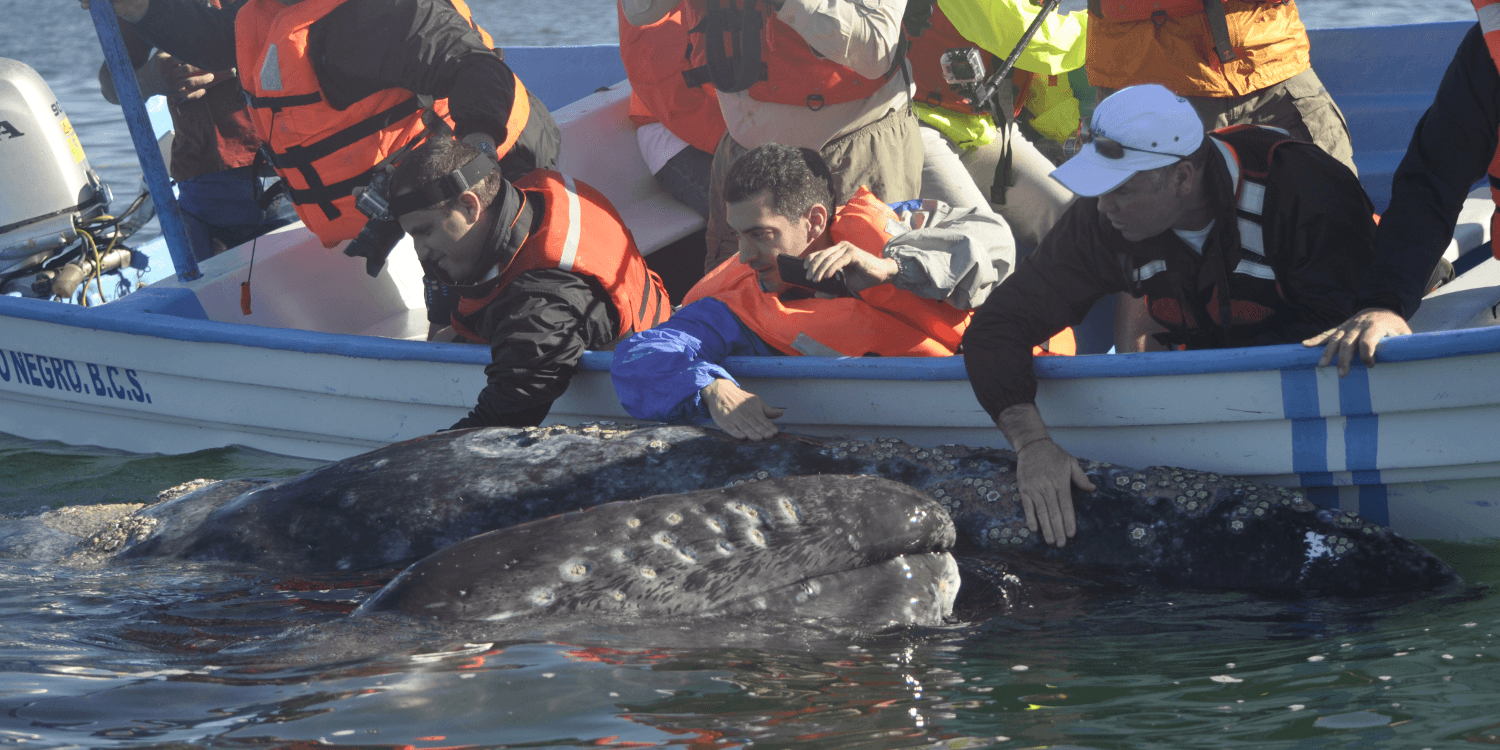
Unlike many mammals and some whale species, the Gray whale males do not engage
in any form of combat to prove who is the biggest, the baddest or the sexiest.
Instead the Gray whales engage in non-monogamous group mating. These whales
are like the hippies of the Pacific Ocean.
A single female in estrus and receptive to males will have multiple partners during the time she is in estrus. It is commonly written that a mating group consists of two males and one female. This might be true. It also might be true that the group is two females and one male. Or there may be 4, 5 and as many as a dozen whales in one mating group at any particular time.
In 2009 I watched a single female and a single male speeding around Laguna Ojo de Liebre in the preliminary “fast swimming” stages of their courtship. They were joined along the way by another solo whale. Then 5 minutes later another whale joined. Then that group of four whales (I do not know how many males and females) swam through an area of the lagoon where a group of 3 were engaged in courtship.
Those two groups joined together and the original couple of whales had swelled to 7 whales in a span of about 15 or 20 minutes. This swarm of mating, racing Gray whales moved across the lagoon in a northerly direction away from our boat. I asked the boat captain to follow. He did his best, but when the mating whales are engaged in their fast swimming it is so darned difficult
to follow them.
He and I did our best to track the group of 7, but lost them for a few minutes as they raced across the lagoon submerged and out of sight. After about 10 minutes we finally came upon the group on the surface once again. But this time the group had grown to perhaps 10 or 12 whales in a large mass. We hung around, watching, taking some photos and just trying not to get squashed by the whales who had something more important on their mind than avoiding a boat load of whale watchers.
Before we left that massive orgy the size had grown beyond our ability to count them all. We eventually agreed there were a minimum of 15 whales from possibly 4 or 5 mating groups that had come together.
A single female in estrus and receptive to males will have multiple partners during the time she is in estrus. It is commonly written that a mating group consists of two males and one female. This might be true. It also might be true that the group is two females and one male. Or there may be 4, 5 and as many as a dozen whales in one mating group at any particular time.
In 2009 I watched a single female and a single male speeding around Laguna Ojo de Liebre in the preliminary “fast swimming” stages of their courtship. They were joined along the way by another solo whale. Then 5 minutes later another whale joined. Then that group of four whales (I do not know how many males and females) swam through an area of the lagoon where a group of 3 were engaged in courtship.
Those two groups joined together and the original couple of whales had swelled to 7 whales in a span of about 15 or 20 minutes. This swarm of mating, racing Gray whales moved across the lagoon in a northerly direction away from our boat. I asked the boat captain to follow. He did his best, but when the mating whales are engaged in their fast swimming it is so darned difficult
to follow them.
He and I did our best to track the group of 7, but lost them for a few minutes as they raced across the lagoon submerged and out of sight. After about 10 minutes we finally came upon the group on the surface once again. But this time the group had grown to perhaps 10 or 12 whales in a large mass. We hung around, watching, taking some photos and just trying not to get squashed by the whales who had something more important on their mind than avoiding a boat load of whale watchers.
Before we left that massive orgy the size had grown beyond our ability to count them all. We eventually agreed there were a minimum of 15 whales from possibly 4 or 5 mating groups that had come together.
The gestation period for gray whales is 11
- 13 months. The gray whales usually give birth in the Baja lagoons, including Laguna Ojo
de Liebre and Laguna San Ignacio, although some whales give birth during their southward
migration, before they reach the lagoons. I theorize that as the species population
has increased, so too has the number of births occurring during the southward swim.
Giving birth early is not a survival characteristic. This may be why so many
youngsters, such a J.J., are found without mothers along the Southern California
shoreline. It is possible the mothers abandon the newborn baby if it is born
too far north.
Another theory is that in years past, Gray
Whales could stop in Los Angeles or San Diego to give birth. There is
now so much traffic and noise that these areas are no longer feasible for the whale to use
as birthing grounds. I tend to put my faith in this second theory. Rather than
abandoning the newborn, the female is just not able to assist it to swim in the deep ocean
outside of the bays and lagoons.
The warm temperature, shallow depth, and
limited access to the open sea, make the Mexican lagoons the ideal places for these marine
mammals to mate and to give birth. The shallow water and narrow entrances are not
conditions that Orcas care for. The Orca uses speed when hunting and pursuing prey
and speed is hard to obtain in the extremely shallow lagoons. The gray whales have
the advantage over the orcas when inside the lagoons!
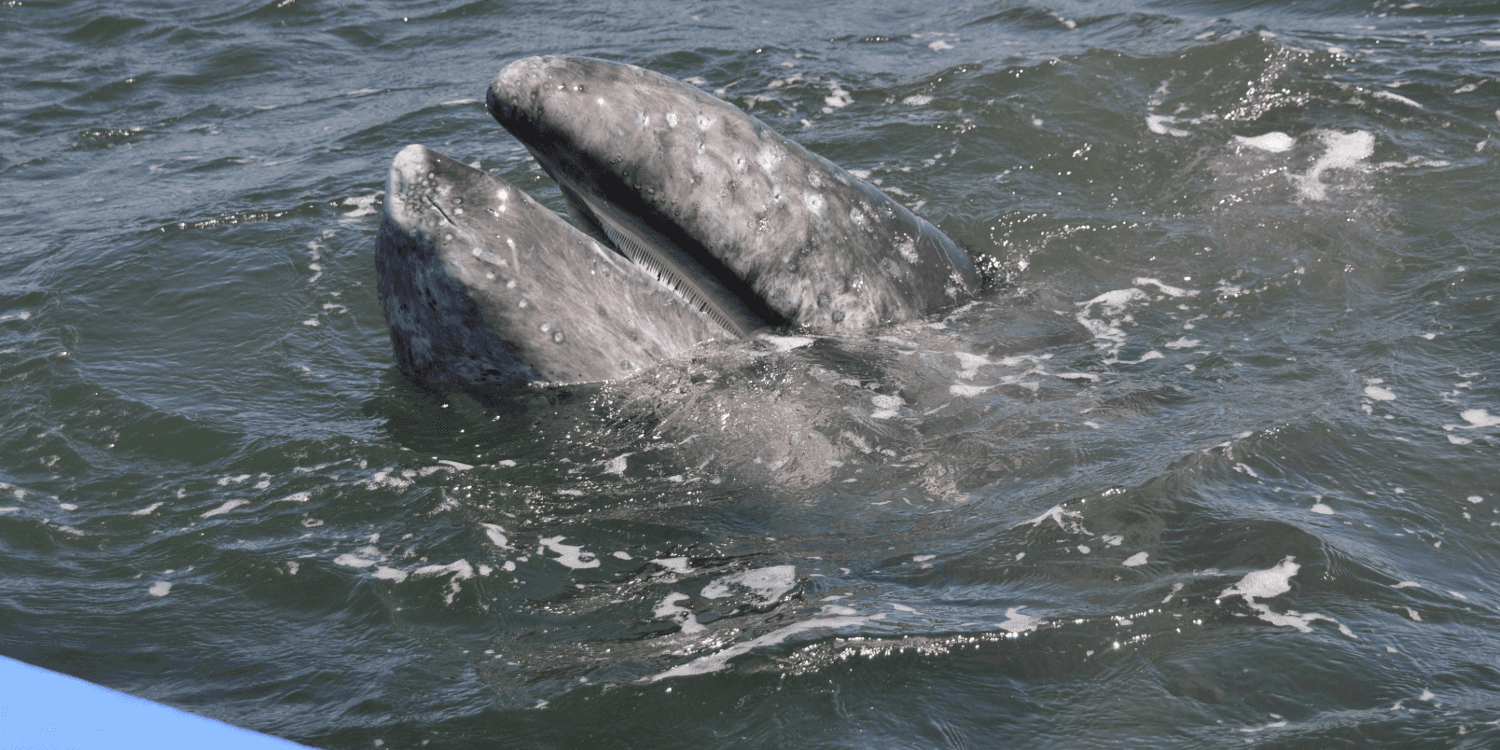
The pregnant females and those with calves
concentrate in the inner lagoon, furthest from the sea. The majority of births occur
between from January to the end of February. The newborn gray whale is around 15 feet long
at birth, weighs around 2000 pounds. The very young calves stay very close to their
mothers during the few months of life. In some cases, another gray whale called an
auntie helps the mother during birth. The auntie may help hold the mother above
water. She may also assist the newborn to the surface for its first breath.
The warmer waters of Mexico help newborns to conserve body heat. They are born lean
and relatively blubberless. The calves nurse for around 6 months, during which time
the mother provides up to 50 gallons of milk each day, containing 53% fat. Calves may gain
60 to 70 pounds daily, building up blubber for their trip north. The whales with calves
prefer the inner part of the lagoon during the first weeks following the birth. Then
as the baby grows the pair venture into the middle of the lagoon. To gain strength for the
5,000 mile journey, the calves practice swimming against the currents in the
lagoons. It is common to see dozens, even scores of mother baby combos slowly
swimming against the incoming or outflowing tide. This exercise is necessary to
prepare the youngster for the coming 5000 mile northward journey. The whales with
offspring leave the interior of the lagoons when the calves are strong and can swim
without problems.
These days there has been an
increase in the number of packs of Killer Whales waiting for the mothers
and babes to begin their
northward journey. There has been a major increase in the quantity of so
called wild
Orcas. That is, those that follow the whale migration route, instead of
hanging out in organized families in the the northern waters, eating fish, and
just chumming around
with the rest of their family group. The wild Orcas form a 5000 mile long
gauntlet through which the young calve must now travel just weeks after their
birth.
Thousands
of gray whales arrive each year
in Baja California. Approximately 900 gray whales visited Laguna Ojo de
Liebre during the
1995 season. In 1996 that number increased to 1,270, in 1997 1,575 gray
whales visited
Laguna Ojo de Liebre, then in 2014 more than 2000 whales were counter,
BUT an amazing 900 babies were counted inn February 2014.
Laguna San Ignacio is the second most frequented site, with 326 whales visiting the lagoon in 1998. Although gray whale births often occur in the lagoons, most whales that migrate to Baja California never enter the lagoons. As the overall population has increased, so too has the frequency of sightings increased. As well, the area of gray whale sightings has broadened so that now there are grays spotted as far south as Cabo and even around into the Gulf of Baja waters.
Want to read about Barnacles?
Laguna San Ignacio is the second most frequented site, with 326 whales visiting the lagoon in 1998. Although gray whale births often occur in the lagoons, most whales that migrate to Baja California never enter the lagoons. As the overall population has increased, so too has the frequency of sightings increased. As well, the area of gray whale sightings has broadened so that now there are grays spotted as far south as Cabo and even around into the Gulf of Baja waters.
The contents of this site, both the photographs and the editorial copy, are
copyright
Keith E. Jones 2015. This means you cannot use the photos without permission.
However permission is hereby granted to any individual who wishes to use photos
or editorial copy as part of an educational report or study, as long as you list
this
publication in your bibliography. For commercial and editorial uses contact
me by
email and I will respond promptly.
EMAIL ME
Or USE OUR CONTACT PAGE
